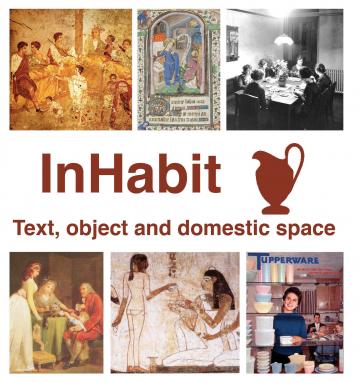inHabit: Text, Object and Domestic Space

This network was funded form 2023 to 2015.
The inHabit: Text, Object and Domestic Space research network focused on the relationships between people, objects and texts within domestic space. These are a series of concepts which are usually considered and conceptualized within discrete disciplinary frameworks, including (but not limited to) literary studies, anthropology, archeology, histories of art, architecture and design. The inHabit research network brought together leading practitioners from a variety of institutions and disciplines to move beyond this compartmentalized perspective to embrace the complex and multi-faceted nature of domestic life.
Domestic space is an important, yet hitherto neglected, framework for exploring how the conflicting demands of being an individual and being part of a group are expressed, negotiated and accommodated. The inHabit network explored those tensions which, manifested in the domestic domain, underlie human existence, through binaries like ease and unease, comfort and discomfort, sufficiency and insufficiency, security and anxiety, continuity and innovation, familiarity and novelty.
Network members:
Amy Bogaard, Institute of Archaeology, University of Oxford
Rebecca Devers, English Faculty, New York City College of Technology
Matthew Jenkins, Department of Archaeology, University of York
Mallica Kumbera Landrus, University Engagement Programme, Ashmolean Museum
Wendy Morrison, Institute of Archaeology, University of Oxford
Charlotte Newman, English Heritage
Andrea Placidi, School of Architecture, Oxford Brookes University
Catherine Richardson, School of English, University of Kent
Damian Robinson, Oxford Centre for Maritime Archaeology, University of Oxford
Kate Spence, Department of Archaeology, University of Cambridge
Stephen Walker, School of Architecture, University of Sheffield
Abigail Williams, Faculty of English, University of Oxford
Contact:
Dr Antony Buxton (Department for Continuing Education)
Dr Linda Hulin (Research Officer, Oxford Centre for Maritime Archaeology, Institute of Archaeology)
Dr Jane Anderson (Programme Lead for Undergraduate Architecture, Oxford Brookes University)
inHabit: Text, Object and Domestic Space

--------------------------------------------------------------------------------------------------------------------------------------------------------------------------------------
Jane Anderson: "The relationship between inhabitation, time and language in the architectural design process".
Seminar - no detail (January 2014)


